热门标签
热门文章
- 1【计算机网络】思科实验(11):综合实验作业之局域网与路由协议_使用3台二层交换机和1台三层交换机实现办公室内跨vlan间的通信
- 2Android 如何监控各个应用的流量和其它乱七八糟的信息_安卓系统命令行怎监测网络用量
- 3什么是数字化转型以及为什么它如此重要?_数字化转型 重要性
- 4【JavaEE】_HTML常用标签
- 5(南京观海微电子)——EDP简介_edp接口抗rf干扰
- 6Docker端口映射_docker run端口映射
- 7vue读取文件夹下面的文件名称_vue获取文件夹下文件名
- 8STM32之USART
- 9compose(docker-images)_docker compose image
- 10云计算虚拟化技术分析及其演进路线_拟态云计算升级路线图
当前位置: article > 正文
跟着Molecular Cancer学作图 -- 分半小提琴图_geom_split_violin()代码
作者:羊村懒王 | 2024-02-07 14:39:36
赞
踩
geom_split_violin()代码

从这个系列开始,师兄就带着大家从各大顶级期刊中的Figuer入手,从仿照别人的作图风格到最后实现自己游刃有余的套用在自己的分析数据上!这一系列绝对是高质量!还不赶紧点赞+在看,学起来!
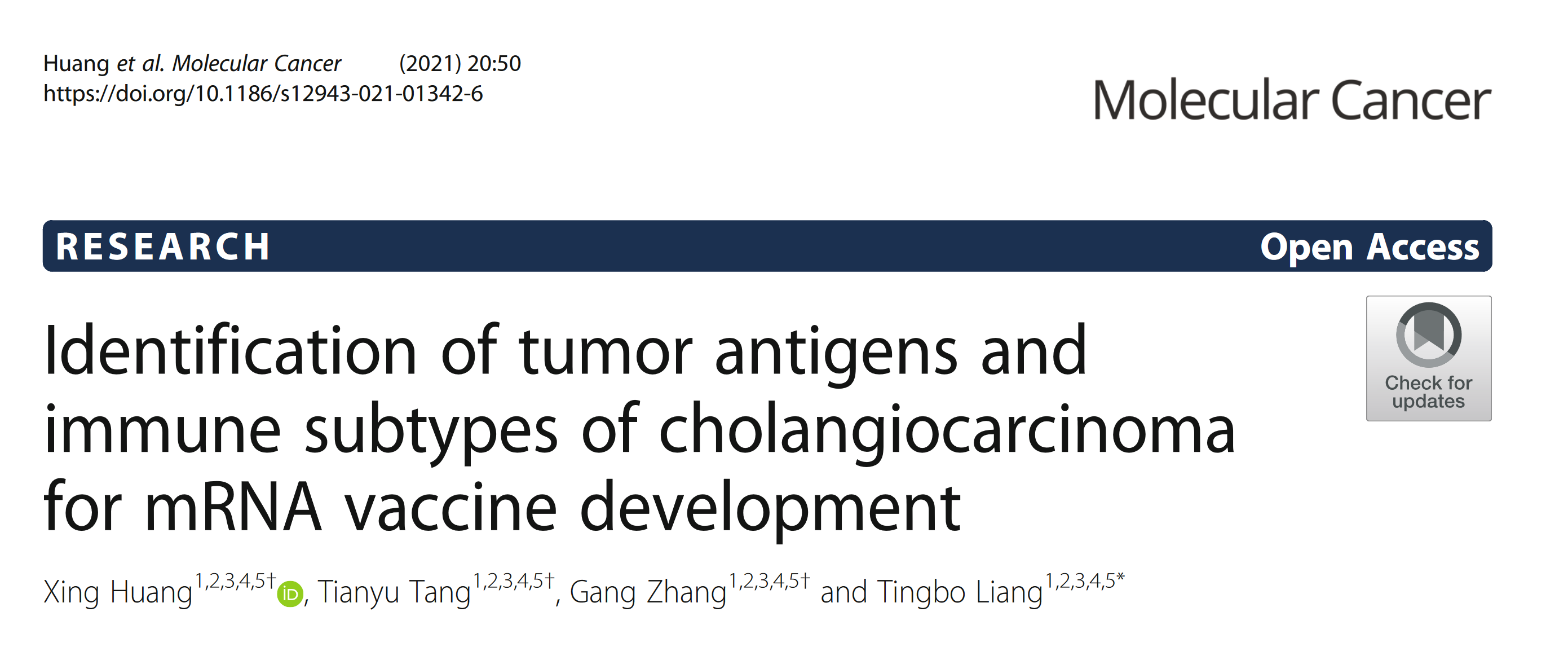
话不多说,直接上图!
示例数据和代码获取
读图
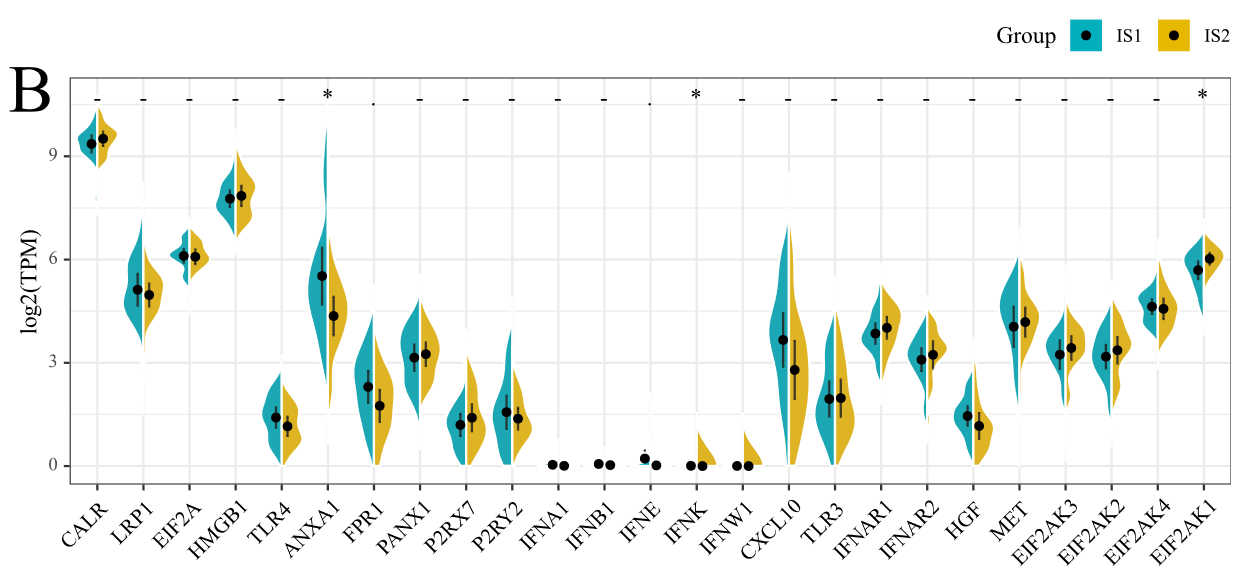
这张图理解起来没什么复杂的,就是一个分组提琴图,然后将两个组的小提琴分别显示一半,这样更方便读者直观比较。本小节我们介绍两种实现方法,一种是基于
gghalves包中的geom_half_violin函数,另一种是借助github大佬编写的geom_split_violin函数。
效果展示
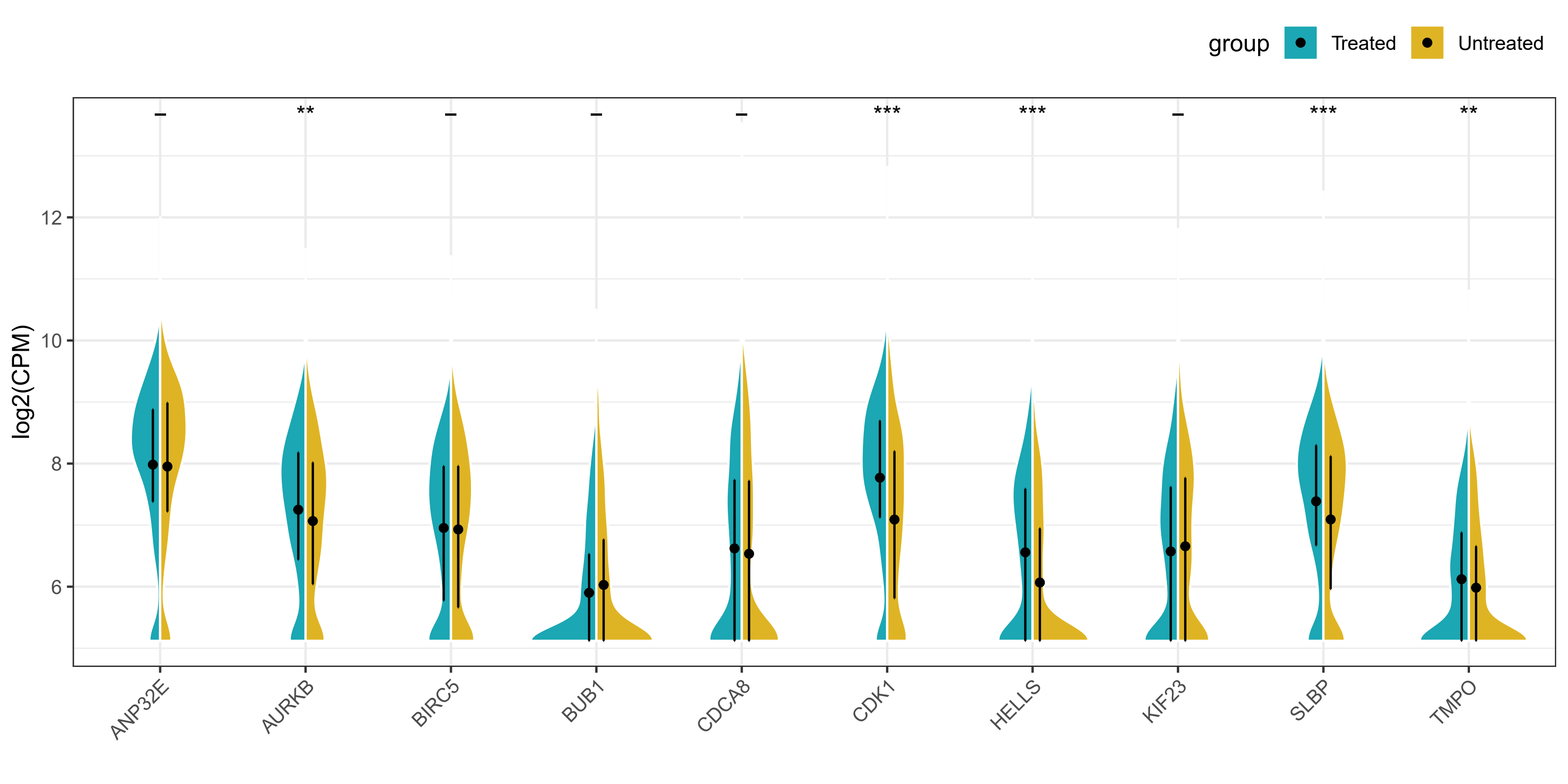
由于本次使用的数据分布并不是很好,所以提琴的形状并不是很美观,但是图形的外观和细节都基本复现了原文。本次复现完全在R语言中进行,请大家放心食用!
数据构建
####################### 分半提琴图 #################### library(ggplot2) library(gghalves) library(tidyverse) # 读取测试数据:此数据集来源于GSE142651,随机挑选25个基因: data <- read.csv("data.csv") data <- data[sample(1:nrow(data), 10),] # 宽数据转长数据: data_new <- data %>% pivot_longer(cols = !X, names_to = "Samples", values_to = "Values") colnames(data_new)[1] <- "Genes" # 添加分组信息: data_new$group <- str_split(data_new$Samples, "_", simplify = T)[,4] # 查看数据 head(data_new) # # A tibble: 6 x 4 # Genes Samples Values group # <chr> <chr> <dbl> <chr> # 1 MCM5 Chip91481_r20_c71_Untreated 7.84 Untreated # 2 MCM5 Chip91481_r47_c21_Untreated 5.12 Untreated # 3 MCM5 Chip91484_r0_c62_Untreated 5.67 Untreated # 4 MCM5 Chip91481_r16_c70_Untreated 5.12 Untreated # 5 MCM5 Chip91484_r0_c35_Treated 6.67 Treated # 6 MCM5 Chip91484_r37_c38_Untreated 5.12 Untreated
- 1
- 2
- 3
- 4
- 5
- 6
- 7
- 8
- 9
- 10
- 11
- 12
- 13
- 14
- 15
- 16
- 17
- 18
- 19
- 20
- 21
- 22
- 23
- 24
- 25
- 26
- 27
- 28
- 29
- 30
- 31
- 32
绘图代码
geom_half_violin函数
# 绘图: ggplot()+ geom_half_violin( data = data_new %>% filter(group == "Treated"), aes(x = Genes,y = Values),colour="white",fill="#1ba7b3",side = "l" )+ geom_half_violin( data = data_new %>% filter(group == "Untreated"), aes(x = Genes,y = Values),colour="white",fill="#dfb424",side = "r" )+ theme_bw()+ xlab("")+ ylab("log2(CPM)")+ geom_point(data = data_new, aes(x = Genes,y = Values, fill = group), stat = 'summary', fun=mean, position = position_dodge(width = 0.2))+ stat_summary(data = data_new, aes(x = Genes,y = Values, fill = group), fun.min = function(x){quantile(x)[2]}, fun.max = function(x){quantile(x)[4]}, geom = 'errorbar', color='black', width=0.01,size=0.5, position = position_dodge(width = 0.2))+ stat_compare_means(data = data_new, aes(x = Genes,y = Values, fill = group), # 修改显著性标注: symnum.args=list(cutpoints = c(0, 0.001, 0.01, 0.05, 1), symbols = c("***", "**", "*", "-")), label = "p.signif", label.y = max(data_new$Values), hide.ns = F)+ theme(axis.text.x = element_text(angle = 45, hjust = 1), legend.position = "top", legend.justification = "right") ggsave("violin_plot.pdf", height = 5, width = 10)
- 1
- 2
- 3
- 4
- 5
- 6
- 7
- 8
- 9
- 10
- 11
- 12
- 13
- 14
- 15
- 16
- 17
- 18
- 19
- 20
- 21
- 22
- 23
- 24
- 25
- 26
- 27
- 28
- 29
- 30
- 31
- 32
- 33
- 34
- 35
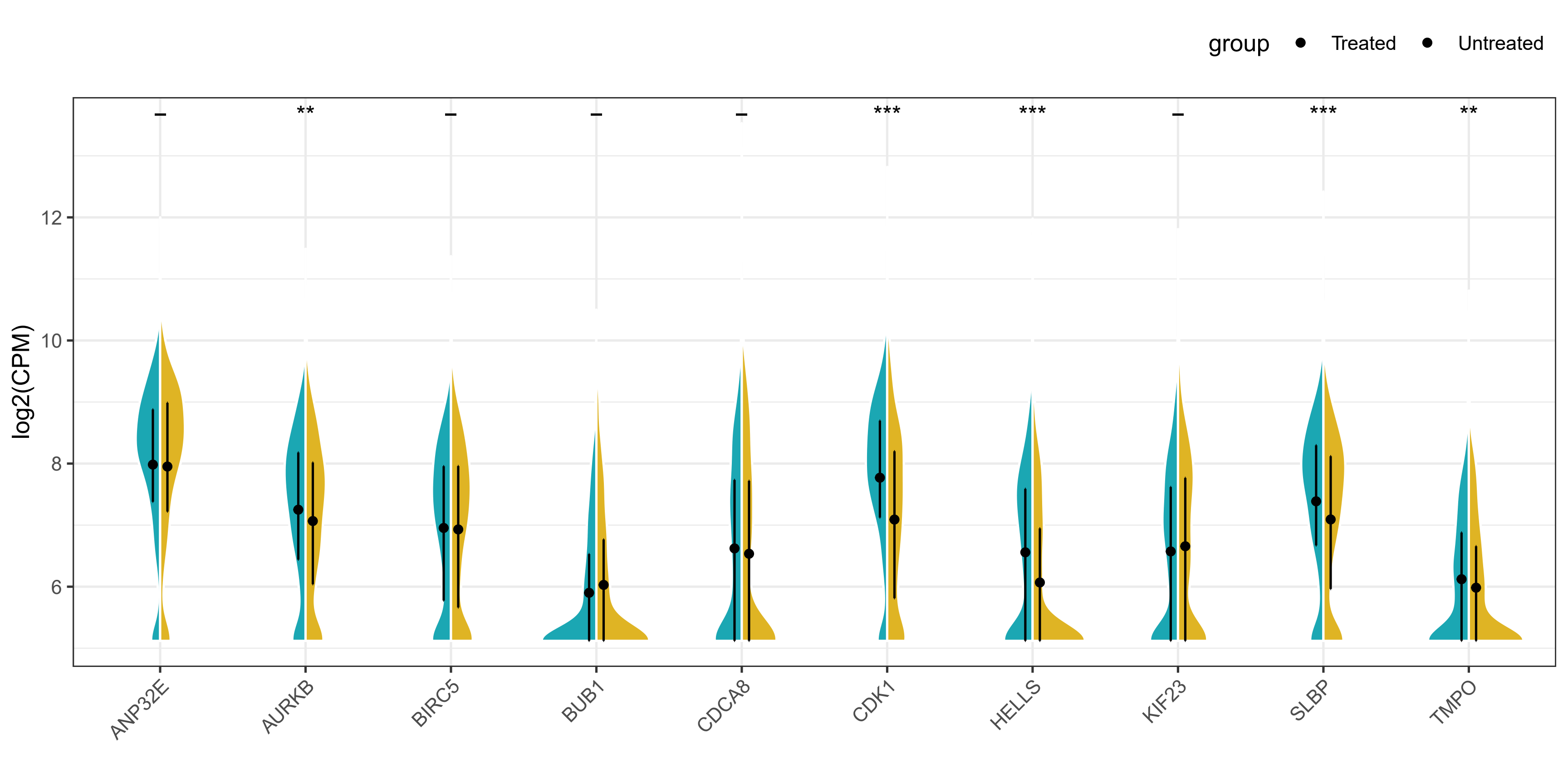
方法二
# 方法二:使用geom_split_violion函数: # 函数来源:https://github.com/tidyverse/ggplot2/blob/eecc450f7f13c5144069705ef22feefe0b8f53f7/R/geom-violin.r#L102 GeomSplitViolin <- ggproto("GeomSplitViolin", GeomViolin, draw_group = function(self, data, ..., draw_quantiles = NULL) { data <- transform(data, xminv = x - violinwidth * (x - xmin), xmaxv = x + violinwidth * (xmax - x)) grp <- data[1, "group"] newdata <- plyr::arrange(transform(data, x = if (grp %% 2 == 1) xminv else xmaxv), if (grp %% 2 == 1) y else -y) newdata <- rbind(newdata[1, ], newdata, newdata[nrow(newdata), ], newdata[1, ]) newdata[c(1, nrow(newdata) - 1, nrow(newdata)), "x"] <- round(newdata[1, "x"]) if (length(draw_quantiles) > 0 & !scales::zero_range(range(data$y))) { stopifnot(all(draw_quantiles >= 0), all(draw_quantiles <= 1)) quantiles <- ggplot2:::create_quantile_segment_frame(data, draw_quantiles) aesthetics <- data[rep(1, nrow(quantiles)), setdiff(names(data), c("x", "y")), drop = FALSE] aesthetics$alpha <- rep(1, nrow(quantiles)) both <- cbind(quantiles, aesthetics) quantile_grob <- GeomPath$draw_panel(both, ...) ggplot2:::ggname("geom_split_violin", grid::grobTree(GeomPolygon$draw_panel(newdata, ...), quantile_grob)) } else { ggplot2:::ggname("geom_split_violin", GeomPolygon$draw_panel(newdata, ...)) } }) geom_split_violin <- function(mapping = NULL, data = NULL, stat = "ydensity", position = "identity", ..., draw_quantiles = NULL, trim = TRUE, scale = "area", na.rm = FALSE, show.legend = NA, inherit.aes = TRUE) { layer(data = data, mapping = mapping, stat = stat, geom = GeomSplitViolin, position = position, show.legend = show.legend, inherit.aes = inherit.aes, params = list(trim = trim, scale = scale, draw_quantiles = draw_quantiles, na.rm = na.rm, ...)) } ggplot(data_new, aes(x = Genes,y = Values, fill = group))+ geom_split_violin(trim = T,colour="white")+ geom_point(stat = 'summary',fun=mean, position = position_dodge(width = 0.2))+ scale_fill_manual(values = c("#1ba7b3","#dfb424"))+ stat_summary(fun.min = function(x){quantile(x)[2]}, fun.max = function(x){quantile(x)[4]}, geom = 'errorbar',color='black', width=0.01,size=0.5, position = position_dodge(width = 0.2))+ stat_compare_means(data = data_new, aes(x = Genes,y = Values), # 修改显著性标注: symnum.args=list(cutpoints = c(0, 0.001, 0.01, 0.05, 1), symbols = c("***", "**", "*", "-")), label = "p.signif", label.y = max(data_new$Values), hide.ns = F)+ theme_bw()+ xlab("")+ ylab("log2(CPM)")+ theme(axis.text.x = element_text(angle = 45, hjust = 1), legend.position = "top", #legend.key = element_rect(fill = c("#1ba7b3","#dfb424")), legend.justification = "right") ggsave("violin_plot2.pdf", height = 5, width = 10)
- 1
- 2
- 3
- 4
- 5
- 6
- 7
- 8
- 9
- 10
- 11
- 12
- 13
- 14
- 15
- 16
- 17
- 18
- 19
- 20
- 21
- 22
- 23
- 24
- 25
- 26
- 27
- 28
- 29
- 30
- 31
- 32
- 33
- 34
- 35
- 36
- 37
- 38
- 39
- 40
- 41
- 42
- 43
- 44
- 45
- 46
- 47
- 48
- 49
- 50
- 51
- 52
- 53
- 54
- 55
- 56
- 57
- 58
- 59
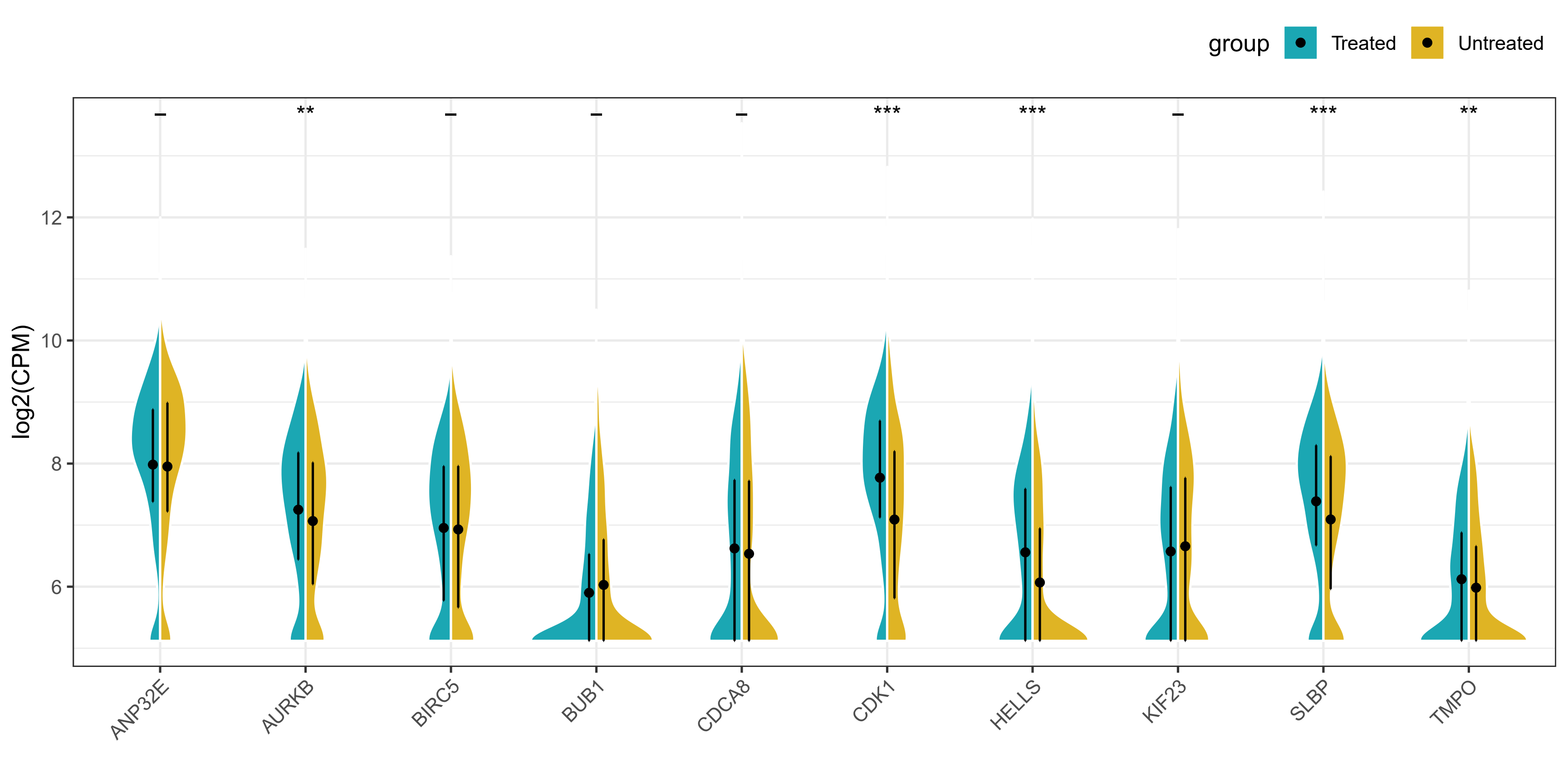
结果展示
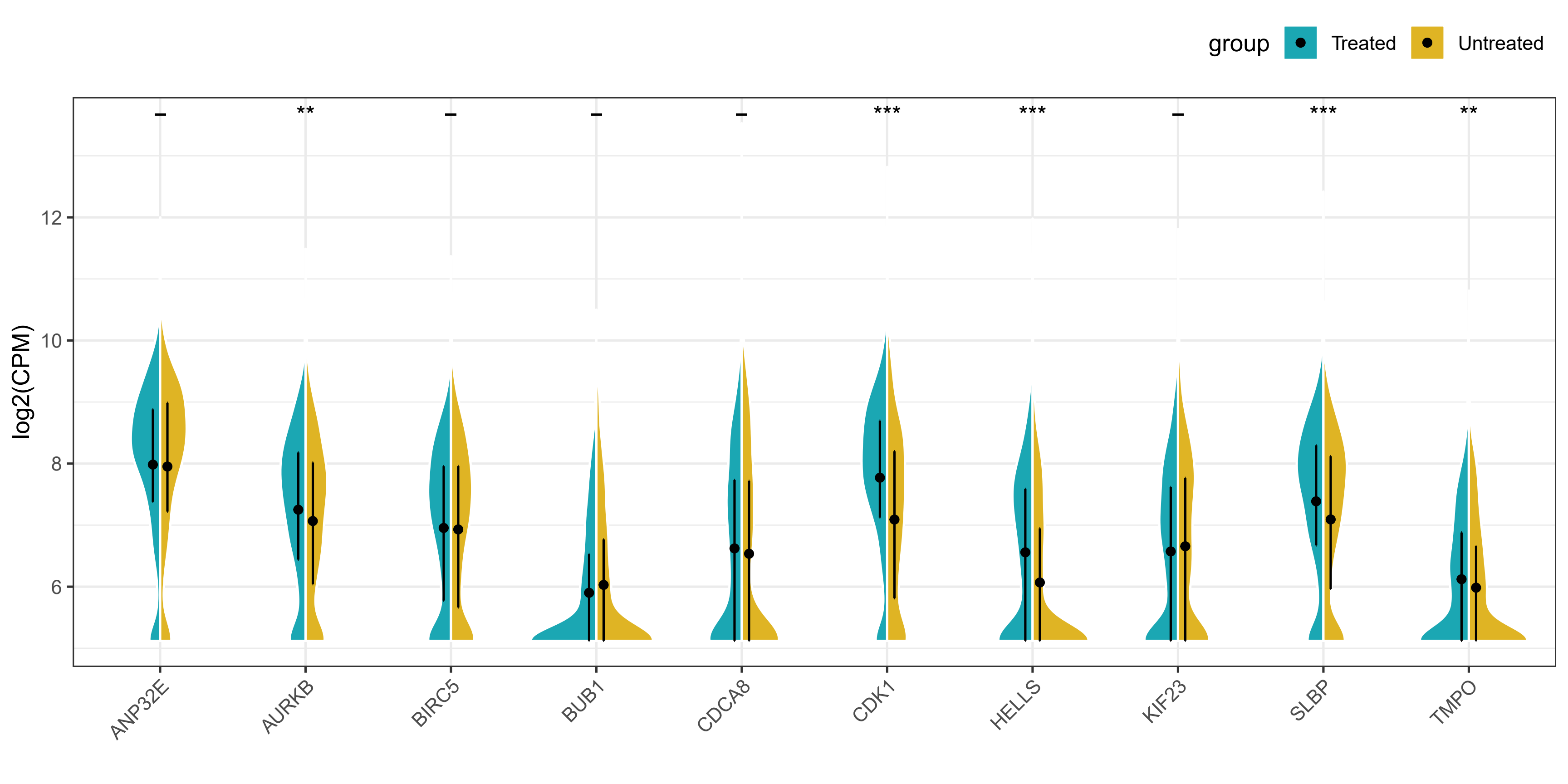
示例数据和代码获取
以上就是本期的全部内容啦!**欢迎点赞,点在看!**师兄会尽快更新哦!制作不易,你的打赏将成为师兄继续更新的十足动力!
往期文章
1. 跟着Nature Medicine学作图–箱线图+散点图
2. 跟着Nature Communications学作图–渐变火山图
3. 跟着Nature Communications学作图–气泡图+相关性热图
4. 跟着Nature Communications学作图 – 复杂提琴图
5. 跟着Nature Medicine学作图–复杂热图
6. 跟着Nature Communications学作图–复杂散点图
7. 跟着Nature Communications学作图 – 复杂百分比柱状图
声明:本文内容由网友自发贡献,不代表【wpsshop博客】立场,版权归原作者所有,本站不承担相应法律责任。如您发现有侵权的内容,请联系我们。转载请注明出处:https://www.wpsshop.cn/w/羊村懒王/article/detail/66025
推荐阅读
相关标签



